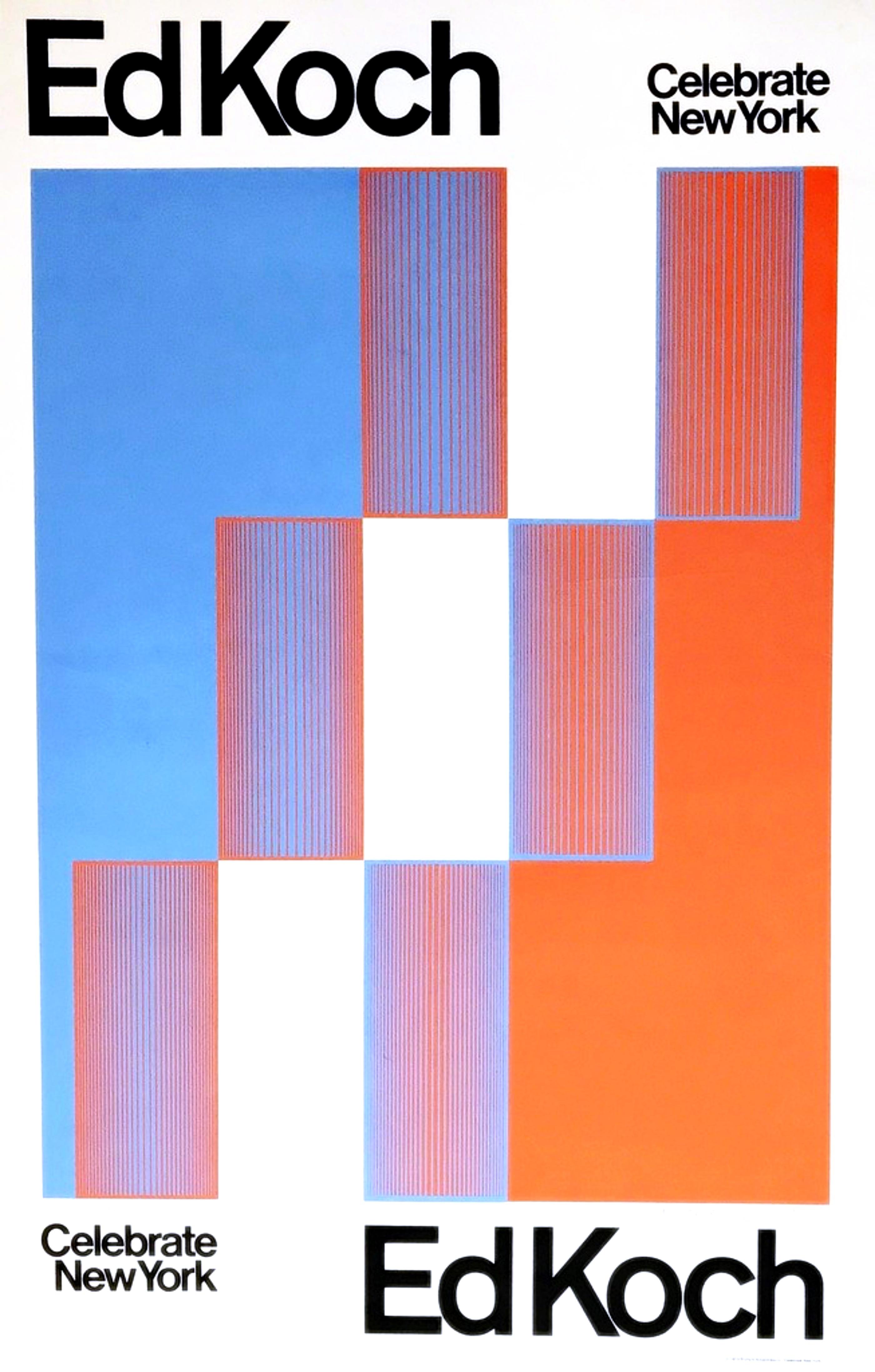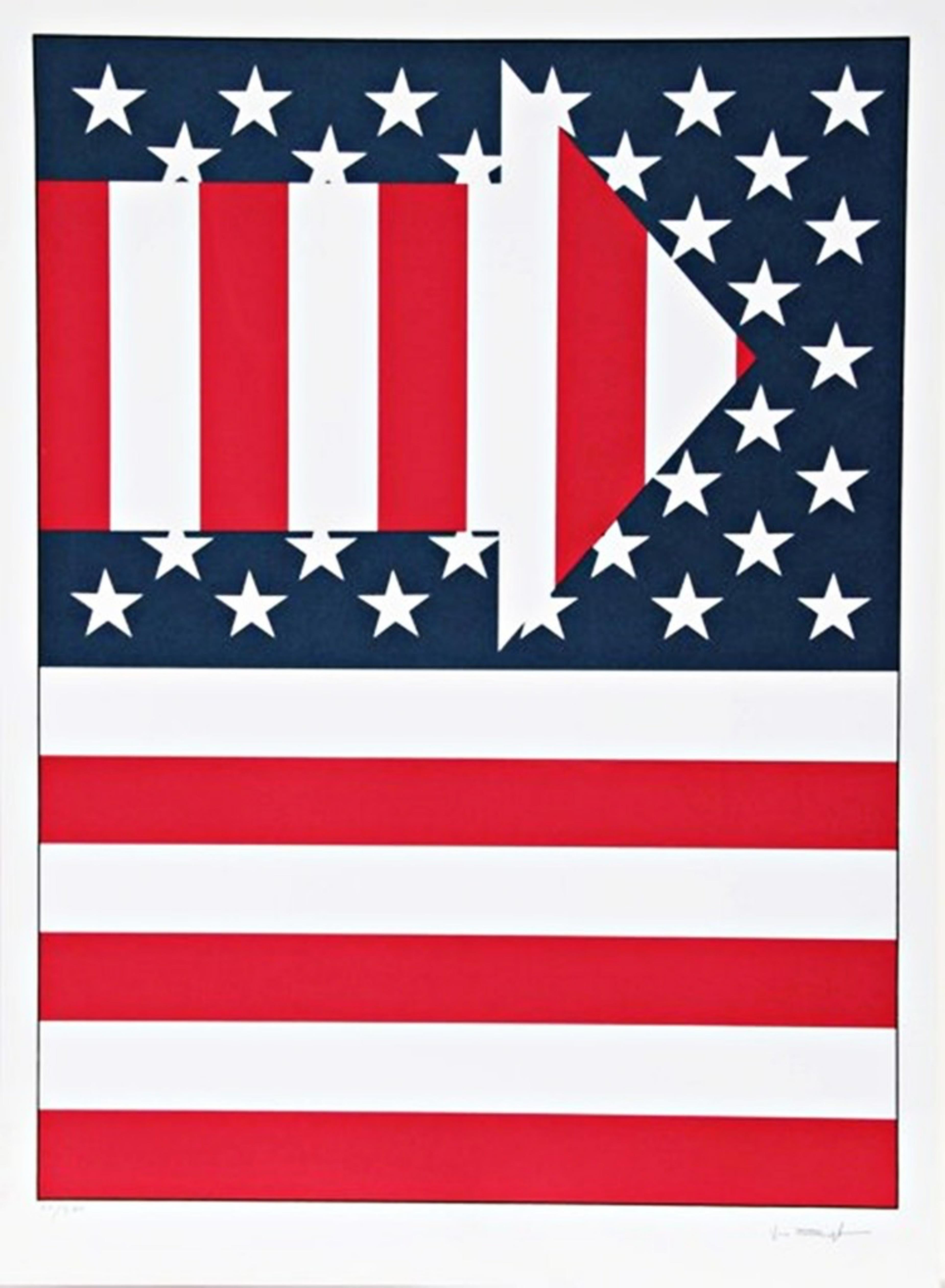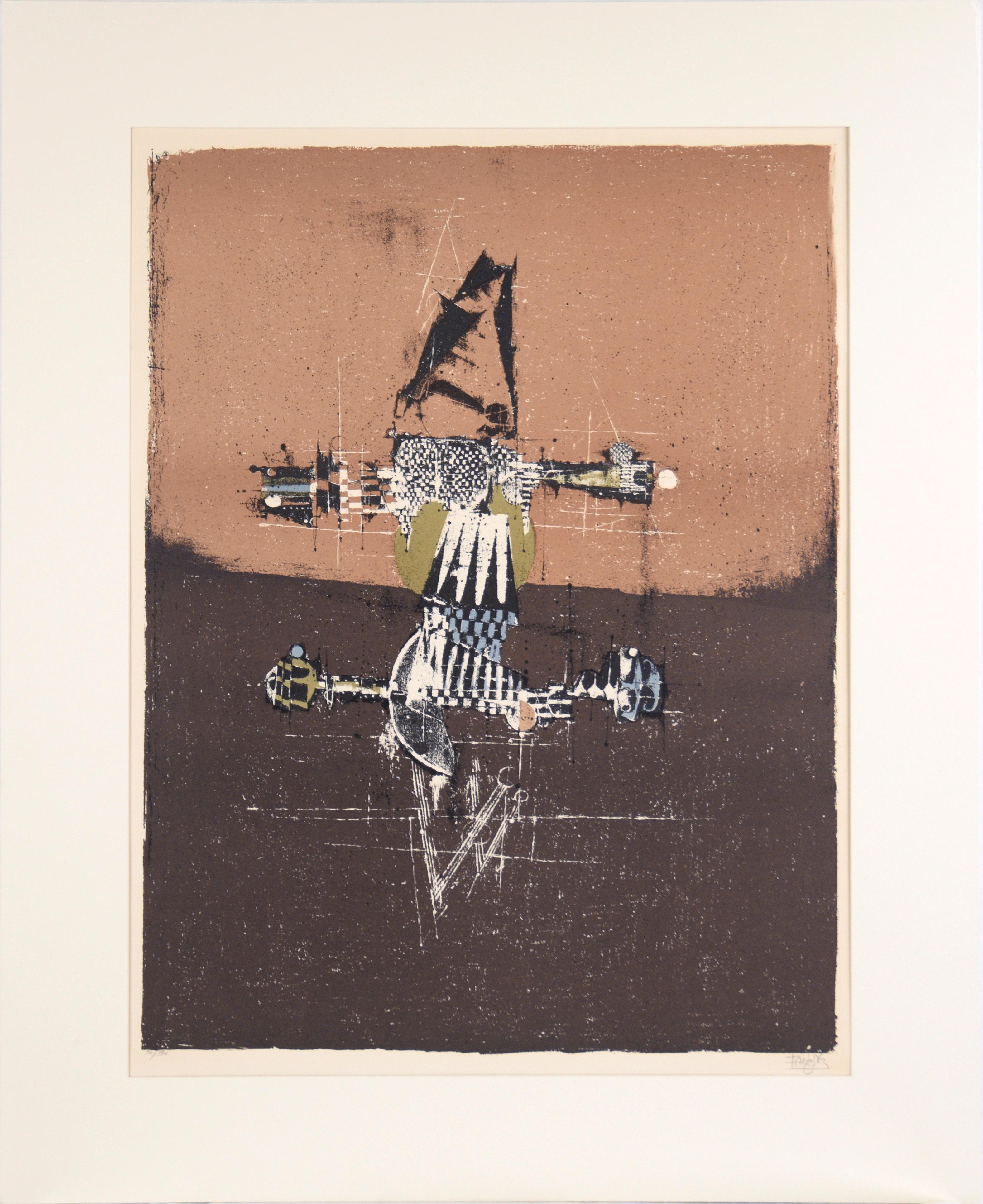Robert IndianaPurim: The Four Facets of Esther (I) Sheehan, 36, Rare signed Printers Proof '661966
1966
About the Item
- Creator:Robert Indiana (1928 - 2018, American)
- Creation Year:1966
- Dimensions:Height: 26.4 in (67.06 cm)Width: 21.4 in (54.36 cm)
- Medium:
- Movement & Style:
- Period:
- Condition:A bright impression with strong colors.
- Gallery Location:New York, NY
- Reference Number:1stDibs: LU1745210983522
Robert Indiana
Robert Indiana's work evolved into hard-edged graphic images of words, logos and typographic forms, earning him a reputation as one of the country's leading contemporary artists.
Indiana is known for using public signs and symbols with altered lettering to make stark and challenging visual statements. In his prints, paintings and constructions, he gave new meaning to basic words like Eat, Die and Love. Using them in bold block letters in vivid colors, he enticed his viewers to look at the commonplace from a new perspective. One indication of his success was the appearance of his immensely popular multi-colored Love on a United States postage stamp in 1973.
Find a collection of original Robert Indiana art today on 1stDibs.
- ShippingRetrieving quote...Ships From: New York, NY
- Return PolicyA return for this item may be initiated within 1 day of delivery.
- I Rather Like You A Lot You Fool, rare 1970 silkscreen signed/N, in museum frameBy Niki de Saint PhalleLocated in New York, NYNiki de Saint Phalle I Rather Like You A Lot You Fool, 1970 Silkscreen on wove paper Signed and numbered 74//75 in graphite pencil on the front Frame included Signed and numbered 74...Category
1970s Abstract Abstract Prints
MaterialsScreen, Pencil, Graphite
- Celebrate New York (hand signed limited edition poster)By Richard AnuszkiewiczLocated in New York, NYRichard Anuszkiewicz Celebrate New York (hand signed limited edition poster), 1974 Silkscreen on wove paper Hand-signed by artist, signed, dated and inscribed "to Lowell" on the fron...Category
1970s Abstract Geometric Abstract Prints
MaterialsScreen
- Duality Triumphant I (Mid Century Modern Geometric Abstraction)By Alfred JensenLocated in New York, NYAlfred Jensen Duality Triumphant I (Mid Century Modern Geometric Abstraction), 1963 Color Silkscreen on wove paper Pencil signed, dated, named and number 19/52 by Alfred Jensen on th...Category
Mid-20th Century Abstract Geometric Abstract Prints
MaterialsScreen
- American Flag III (Geometric Abstraction Hard Edge Minimalist Abstraction) S/NBy Paul von RingelheimLocated in New York, NYPAUL VON RINGELHEIM American Flag III, 1979 Silkscreen in Colors on wove paper Signed and numbered in graphite pencil on the lower margin front 31 × 23 inches Unframed Hand signed and numbered from the limited edition of 300. Born in Vienna Austria, but working in the US for many decades, Von Ringelheim, also known as a sculptor, brought his unique hard-edge minimalistic geometric abstraction outsider's take on the American Flag to this vintage 1970s limited edition, signed silkscreen. Unframed and in fine condition. Ringelheim was represented in the 1960s by the legendary Rose Fried Gallery...Category
1970s Abstract Geometric Abstract Prints
MaterialsScreen
- Rainbow Signed 1970s silkscreen & lithograph by pioneering female Fluxus artistBy Mary BauermeisterLocated in New York, NYMary Bauermeister Rainbow, 1973 Lithograph and silkscreen on creamy white paper Hand signed, dated and numbered 56/250 by the artist on the front 19 x 25.5 inches Unframed This work is on the permanent collection of various institutions like: Rice University, Samuel Dorksy Museum of Art, Rutgers Zimmerli Museum and Wheaton College Massachusetts. While studying the fringe sciences the 1970s, Bauermeister created Rainbow (1973), a lithograph and silkscreen. She uses a creamy white background as the base. Two intersecting diagonal bands of color transcend across the page, and black cursive lettering dances over the surface serving as a mind map of interweaving ideas. Through the central band, Bauermeister shifts through the color spectrum; she begins with red and finishes with violet. Inspired by music, she uses strokes of color that are rhythmically smeared across the lithograph. The surface lettering, a kind of visual poetry, explores her interest in human emotion and science. The viewer can see Bauermeister’s thoughts as they flow into one another through the use of words such as bliss, love, and healing. Bauermeister also includes a repetition of words such as cancer, sickness, and cure. The word cancer emerges from a cell-like shape. A careful study of the words shows that they may seem dark in nature; however, she juxtaposes these words against the cheerful title and colors. Perhaps the rainbow symbolizes a new hope, an inspiration for an optimistic future. -Courtesy to the Samuel Dorsky Museum of Art About Mary Bauermeister: A multidisciplinary artist known for her intricate and enigmatic assemblages, Mary Bauermeister (1934-2023) continues to defy categorization with layered works in a range of media. A precursory figure of the Fluxus movement—her studio was the meeting point for a number of defining artists of the avant-garde—her work plays an integral role in the discussion of art, both European and American, that emerged from the 1960s. Her reliefs and sculptures, which have incorporated drawing, text, found objects, natural materials and fabric, reference a plethora of concepts: from natural phenomena and astronomy to mathematics and language, as well as her own “spiritual-metaphysical experiences.” Maturing amidst the currents of Minimalism and Pop Art, Bauermeister’s art has resisted labels due to the singular expression of her interests and concerns, among them the simultaneous transience and permanence of the natural world with experimentations in transparency and magnification, multiplication and variation, structure and order, chance and ephemerality, introversion and extroversion. Her three-dimensional receptacles of thoughts, ideas, and notes contain visual, conceptual, and philosophical paradoxes that challenge perceptions and that offer literal and metaphorical windows into which one can glimpse the inner workings of the artist’s mind. - Courtesy of Michael Rosenfeld...Category
1970s Modern Abstract Prints
MaterialsLithograph, Screen, Mixed Media, Pencil, Graphite
- Eddie (Sylvie's Brother) in the Desert (celebrated 1960s silkscreen) Signed/NBy Oyvind FahlstromLocated in New York, NYÖyvind Fahlström Eddie (Sylvie's Brother) in the Desert (from New York International Portfolio), 1966 Silkscreen on wove paper Pencil signed and numbered from the limited edition of ...Category
1960s Pop Art Abstract Prints
MaterialsScreen, Pencil, Graphite
- Gordon House, "Dial Set One, " Screenprint, 1966By Gordon HouseLocated in Long Island City, NYThis screenprint was created by Welsh artist Gordon House (1932-2004). House was a designer and painter whose hard-edged abstract works reflected the dramatic tensions of his graphic...Category
1960s Abstract Geometric Abstract Prints
MaterialsScreen
- "Haarlem" Aquatint Etching on PaperBy Johnny FriedlaenderLocated in Soquel, CABold abstract aquatint by Johnny Friedlaender (Polish-French, 1912-1992). Comprised of two main sections, this piece is full of detail and texture. The upper layer is a reddish tan, whereas the bottom layer is a rich brown. Geometrical shapes are arranged such that they almost form mirror images of each other, but vary enough to create interest and a sense of movement. Signed in the lower right corner. Numbered 56/350 in the lower left corner. Includes original certificate of authenticity. Presented in a new cream mat with foamcore backing. Mat size: 42"H x 32"W Paper size: 33.75"H x 24.5"W Johnny Friedlaender was a leading 20th century artist, whose works have been exhibited in Germany, France, Netherlands, Italy, Japan and the United States. He has been influential upon other notable artists, who were students in his Paris gallery. His preferred medium of aquatint etching is a technically difficult artistic process, of which Friedlaender has been a pioneer. Johnny Gotthard Friedlaender was born in Pless (Silesia) and his early studies were in Breslau under Otto Mueller. In 1936 Friedlaender journeyed to Czechoslovakia, Switzerland, Austria, France and Belgium. At the Hague he held a successful exhibition of etchings and watercolours. He fled to Paris in 1937 as a political refugee of the Nazi regime with his young wife, who was an actress. In that year he held an exhibition of his etchings which included the works: L 'Equipe and Matieres et Formes. From 1939 to 1943 he was interned in a series of concentration camps, but survived against poor odds. After freedom in 1944 Friedlaender began a series of twelve etchings entitled Images du Malheur with Sagile as his publisher. In the same year he received a commission to illustrate four books by Freres Tharaud of the French Academy. In 1945 he performed work for several newspapers including Cavalcade and Carrefour. In the year 1947, he produced the work Reves Cosmiques, and in that same year he became a member of the Salon de Mai, which position he held until 1969. In the year 1948 he began a friendship with the painter Nicolas de Stael and held his first exhibition in Copenhagen at Galerie Birch. The following year he showed for the first time in Galerie La Hune in Paris. After living in Paris for 13 years, Friedlaender became a French citizen in 1950. Friedlaender expanded his geographic scope in 1951, and exhibited in Tokyo in a modern art show. In the same year he was a participant in the XI Trienale in Milan, Italy. By 1953 he had produced works for a one-man show at the Museum of Neuchâtel and exhibited at the Galerie Moers in Amsterdam, the II Camino Gallery in Rome, in São Paulo, Brazil and in Paris. He was a participant of the French Italian Art Conference in Turin, Italy that same year. Friedlaender accepted an international art award in 1957, becoming the recipient of the Biennial Kakamura Prize in Tokyo. In 1959 he received a teaching post awarded by UNESCO at the Museum of Modern Art in Rio de Janeiro. By 1968, Friedlaender was travelling to Puerto Rico, New York and Washington, D.C. to hold exhibitions. That year he also purchased a home in the Burgundy region of France. 1971 was another year of diverse international travel including shows in Bern, Milan, Paris, Krefeld and again New York. In the latter city he exhibited paintings at the Far Gallery, a venue becoming well known for its patronage of important twentieth century artists. From his atelier in Paris Friedlaender instructed younger artists who themselves went on to become noteworthy, among them Arthur Luiz Piza, Brigitte Coudrain, Rene Carcan...Category
1970s Abstract Geometric Abstract Prints
MaterialsPaper, Etching, Aquatint
- S.S. De GrasseBy Ralston CrawfordLocated in Belgrade, MTOriginal Lithograph signed by the artist and numbered 156/200, and is a limited edition. Ralston Crawford was born in Saint Catherine's , Ontario in 1906. He came to the U.S. in 1910...Category
Mid-20th Century Abstract Geometric Abstract Prints
MaterialsLithograph
- Original Weltcup Slalom Damen vintage downhill ski posterBy Niklaus TroxlerLocated in Spokane, WAOriginal ski poster for the World Cup Slalom Damen (Women's) Feb/. 1987. Linen backed. Original vintage winter sport alpine ski event poster for the Women's Slalom World Cup 198...Category
1980s Abstract Geometric Figurative Prints
MaterialsOffset
- Coffee Time, Monotype on Paper, 20 x 20, Venezuelan Artist, Geometric AbstractLocated in Houston, TXCoffee Time Medium: Monotype on archival paper Size: 20 x 20 by South American/Venezuelan artist Luisa Duarte is an example of geometric abstract art . Lu...Category
2010s Abstract Geometric Abstract Prints
MaterialsArchival Paper
- Si Me Rompes Me Remiendo 2, Monotype/Paper, 20 x 20, Venezuelan Artist , MOMALocated in Houston, TXSi Me Rompes Me Remiendo 2 Medium: Monotype on archival paper Size: 20 x 20 by South American/Venezuelan artist Luisa Duarte is an example of geometric a...Category
2010s Abstract Geometric Abstract Prints
MaterialsArchival Paper





